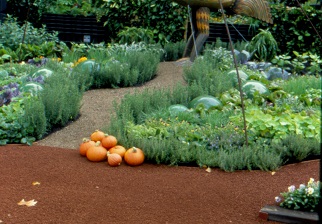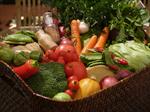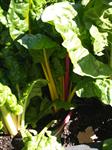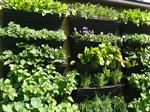Learn How to Design and Plan Natural Gardens by Distance Learning
 Permaculture seeks to increase sustainability and biodiversity, lessen input, grow plants that have more than one use and that are actually used rather than just grown. Many plants will perform these functions. Plants that are grown as culinary herbs can have medicinal qualities, trees that bear nuts and fruit feed people and animals, provide windbreaks, animal shelters and alter microclimates. Some provide fodder for animals, fix nitrogen in the soil, provide mulch, are beneficial companions to other plants, improve the soil and attract insects. Others provide wood for fuel and timber for buildings and fences.
Permaculture seeks to increase sustainability and biodiversity, lessen input, grow plants that have more than one use and that are actually used rather than just grown. Many plants will perform these functions. Plants that are grown as culinary herbs can have medicinal qualities, trees that bear nuts and fruit feed people and animals, provide windbreaks, animal shelters and alter microclimates. Some provide fodder for animals, fix nitrogen in the soil, provide mulch, are beneficial companions to other plants, improve the soil and attract insects. Others provide wood for fuel and timber for buildings and fences.
Discover Sustainable Gardening Practices
Completion of this course will help you to develop your ability to independently prepare plans for a permaculture system appropriate for particular environments and sites. Learn about the different growing methods which underpin permaculture, natural systems which constitute ecology i.e. the relationships between water, soils, plants and animals, zonal planning in permaculture systems and how plants, animals, fish and other components fit in. The course culminates in designing a permaculture system and preparing drawings.
- Tutors in this course hold an authentic PDC.
- ACS is a Member of the Permaculture Association (UK), The Institute of Horticulture (UK), and the Alternative Technology Association (Australia).
What is Permaculture?
Permaculture is a philosophy which encompasses the establishment of environments which are highly productive, stable and harmonious and which provide food, shelter, energy etc., as well as supportive social and economic infrastructures. It involves developing a garden or farm where the plants and animals are put together in such a way that they support each other's growth and development. The garden or farm may very well change over the years, but it always remains productive, requires little input once established, and is environmentally sound.
Study for the Permaculture Design Certificate
This course was developed to encompass and go beyond the curriculum of the Permaculture Design Certificate, as set down by the Permaculture Institute.
To obtain the PDC, the permaculture tutor must be satisfied of your knowledge and understanding of permaculture. To that end, we require that students wanting to achieve the PDC take the ACS DE exam at the end of the Permaculture Systems course.
For further details on how to study for a PDC, please read The Permaculture Design Certificate page.
Course Structure and Lesson Content
The course comprises 8 lessons as detailed, below.
Lesson 1. Permaculture Principles
-
Nature and scope
- Principles of permaculture
- Location
- Functions
- Elements
- Elevation planning
- Biological resources
- Recycling energy
- Diversity
- Natural succession
- Maximising edges
- Other concepts and systems that have been incorporated into permaculture
- Sustainability
- Organics
- No dig gardening
- No till planting
- Crop rotation
- Green manure cropping
- Composting
- Companion planting
- Pest and disease prevention and management
Lesson 2. Natural Systems
- Ecosystems
- Abiotic components of an ecosystem
- Biotic components of an ecosystem
- Ecological concepts and terms
- Biomass
- Understanding climate
- Microclimates
- Degree days
- Water in permaculture systems
- Minimising water needs
- Arid landscapes
- Irrigation
- Using swales
- Reed beds for waste water treatment
- Reed bed plant species
- Hydrological cycle
- Water - Direct fall onto land surface, intercepted fall, fall onto water bodies
- Rainfall, Evaporation, Infiltration
- Effective rainfall
- Soil Environments - micro organisms, organic matter
- Types of soil degradation
- Types of erosion & control
- Salinity and its control
- Soil acidification and management of pH
- Wildlife in a Permaculture system
- Structure of a Permaculture system
- Plants and their function in permaculture
- Guilds and stacking
- Successions
Lesson 3. Zone and Sector Planning
- Scope and nature
- Five standard zones
- Sectors
- Landscape profile
- Site selection
- Pre-planning information; what is needed and how to find it
- Procedure for concept design; step by step
- Recording site and locality details
Lesson 4. Permaculture Techniques
- Forests and trees
- Trees as energy transducers
- Types of forests; fuel, food, forage, shelter, barrier, structural, conservation
- Forest establishment
- Designing fire or wind break
- Fire resistant plants
- Mandala gardens & their construction
- Keyhole beds
- Water bodies in a permaculture system
- Water body design
- Water containment options
- Water plants
- Managing water bodies
Lesson 5. Animals in Permaculture
- Location for animals
- Functions for animals in a permaculture system
- Bees, poultry, pigs, cattle
- Grazing animals
- Types of fencing (post and rail, hedge, wire, barbed wire, electric, banks and rises, gates
- Animal water supply
- Shelter for animals - trees, a valley, purpose built shelter
- Birds
- Earthworms
- Aquaculture scope and nature
- Aquaculture production systems (EP and IP)
- Aquaculture species
- Aquaculture management
- Harvesting fish
Lesson 6. Plants in Permaculture
- Scope and nature of plants for use in permaculture
- Growing vegetables organically
- Physical characteristics of a soil
- How to test and name a soil
- Chemical characteristics of a soil
- Soil nutrition
- Fertilisers
- Animal manures
- Liquid plant feeds
- Rock dusts
- Nitrogen fixation
- Mycorrhyzae
- Identifying plant nutrient deficiencies
- Using mulches
- Types of mulch
- Weed management
- Preventative weed control
- Other methods of weed control
- Culture of selected permaculture plants - asparagus, black locust, cassava, chicory, dandelion, endive, fennel, garlic, ginger, horseradish, leek, mint, okra, pigface, rhubarb, sweet potato, tarowarrigul greens, water cress, water spinic, yams
- Culture of selected fruits - apple, apricot, cherry, citrus, fig, loquat, nasi pear, olive, peach, pear, plum, quince
- Culture of selected tropical fruits - avocado, banana, carambola, coconut, custard apple, guava, mango, paw paw, pepino, pineapple
- Culture of selected vines - grape, passion fruit, kiwifruit
- Culture of selected berries
- Culture of selected nuts
- Culture of rarer nuts
- Crop plants which grow in shade
- Fodder plants
- Plant pest and disease management for permaculture
- Plants with insecticidal properties
Lesson 7. Appropriate Technologies
- Scope and nature of appropriate technology
- Solar energy
- Wind energy
- Methane
- Biofuel power
- Composting toilets
- Energy efficient housing
- Living fences (hedges, hedgerows etc)
- Water recycling
- Domestic needs - climate control, space heating, washing and drying clothes, cooking and cook stoves, refrigeration and cooling, hot water supplies, water conservation, electricity and lighting
- Alternative energy and management
- Waste disposal: kitchen waste, non composting waste, recycling
- Biological filtration system
- Conservation and recycling
- Types of waste water (liquid waste, grey water, black water)
- Energy conservation
- Solar energy
- Solar greenhouses
Lesson 8. Preparing a Plan
- Scope, nature and methods
- Designing for natural disasters
- Drawing a plan
- Developing the final design
Course Aims
- Explain the principles of permaculture.
- Explain the concepts of natural systems.
- Explain permaculture techniques involving zones and sector planning.
- Explain a range of permaculture techniques: (forest plantings, mandala gardens, ponds etc.).
- Explain the significance of different animals in a permaculture system.
- Select plants appropriate for inclusion in a permaculture system, to supply a useful and sustained harvest; explain their husbandry.
- Select appropriate technologies for use in permaculture systems.
- Draw permaculture designs (plans) to scale.
What You Will Do
- Differentiate between permaculture and other sustainable systems.
- Explain the procedures followed in practising different techniques which are sympathetic to permaculture, including: No-dig gardening, Companion Planting, Biological control, and Sustainable harvesting.
- Explain the interactions that occur between living and non-living components in five different natural environments, including: Forest Systems, Aquatic Environments, Soil Environments, and Arid Environments.
- Evaluate different permaculture designs against the nine permaculture principles.
- Distinguish between different garden zones in a permaculture system.
- Explain sector planning in a specific garden design.
- Design a mandala garden for a specific site.
- Determine the appropriate use of swales on a sloping site.
- Investigate distinctly different permaculture systems.
- Explain three different cultural techniques used to minimise the maintenance requirement in permaculture systems you study.
- Determine different animal breeds, which can provide a useful and sustained harvest from a permaculture system in your locality.
- Describe the harvest, treatment and use of various products derived from different types of animals in a permaculture system.
- Explain the factors which can affect the success of different types of animals, in a permaculture system, including: Poultry, Aquatic animals, Domestic farm animals, Insects, Earthworms.
- Describe the husbandry of one specified type of animal, in a permaculture system visited by you.
- Determine different species of plants which can provide a useful, sustained harvest from a permaculture system.
- Describe the harvest, treatment and use of various products derived from twenty different plant genera in a permaculture system.
- Compile a resource file of fifty information sources for different plants which can be incorporated into permaculture systems.
- Explain the factors which can affect the survival of different types of plants, including those used for: Vegetables, Fruits, Herbs, Fibres, Building materials, and Fuel.
- Explain the husbandry of one specified type of plant, in a permaculture system visited by you.
- Explain the relevance of appropriate technology to permaculture design.
- Compare three different waste disposal techniques which may be used for kitchen scraps in a permaculture system.
- Compare three different waste disposal techniques which may be used for effluent in a permaculture system.
- Evaluate the suitability of different building techniques in a permaculture system.
- Explain the application of two different systems of alternative energy in a permaculture system.
- Compare differences in the impact on a permaculture system, of three alternative technologies designed for the same purpose (e.g. three alternative sources of electricity).
- Evaluate the use of technology in a house (you choose the house).
- Determine more "appropriate" technologies to replace currently used technologies, in a house you evaluate.
- Illustrate on a plan, twenty different components of a design, including: Plants, Buildings, and Landscape features.
- Transpose a simple permaculture plan to a different scale.
- Represent an existing site, drawn to scale, on a plan.
- Describe the stages involved in the process of producing a permaculture design.
- Prepare a concept plan for a permaculture system surveyed by you, which is between five hundred and one thousand square metres in area.
- Prepare a detailed design for a permaculture system of between five hundred and one thousand square metres in size, including: scale drawings, materials specifications, lists of plant and animal varieties.
Is Permaculture for You?
 Permaculture is a system of agriculture based on perennial, and self-perpetuating, multi-use plants and animal species which are useful to man. In a broader context, permaculture is a philosophy which encompasses the establishment of environments which are highly productive, stable and harmonious and which provide food, shelter, energy etc., as well as supportive social and economic infrastructures.
Permaculture is a system of agriculture based on perennial, and self-perpetuating, multi-use plants and animal species which are useful to man. In a broader context, permaculture is a philosophy which encompasses the establishment of environments which are highly productive, stable and harmonious and which provide food, shelter, energy etc., as well as supportive social and economic infrastructures.
Permaculture copies patterns from nature, it focuses on the way elements are placed in the landscape and in the way they inter-relate, rather then on the individual elements.
Other then food production, permaculture encompasses the use of appropriate technology e.g. energy efficient buildings, recycling, waste water treatment, solar and wind energy and composting toilets.
In comparison to modern farming techniques practised in Western Civilisation, the key elements of permaculture are low energy and high diversity inputs. The design of the landscape, whether on a suburban block or a large farm, is based on these elements.
Ethical and Sustainable
 Permaculture is an ethical approach to designing land use and community systems, to provide food, ecological habitats and other essentials needed for human survival.
Permaculture is an ethical approach to designing land use and community systems, to provide food, ecological habitats and other essentials needed for human survival.
The term 'permaculture' comes from the words 'PERMAnent' and 'agriCULTURE', and implies the permanence of culture. The term was first devised in 1978 by Bill Mollison (an Australian ecologist) and his student David Holmgren.
It embraces three main ethical principles as follows:
- "Care of the Earth" - this includes all living things and non living things which together comprise the environment (i.e.. animals, plants, land, water and air).
- "Care of People" - permaculture systems should be developed to promote self reliance and community responsibility.
- "Fair Share" - set limits to consumption and reproduction, and redistribute surplus - pass on anything surplus to an individual's needs (e.g. labour, information or money) in an attempt to pursue the above aims.
Implicit in the above is the 'Life Ethic': all living organisms are not only means, but ends. In addition to their instrumental value to humans and other living organisms, they have an intrinsic worth.
As such permaculture stresses a positive approach and an attitude of cooperation, with respect to the environment and all living things.
Principles of Design
Permaculture is a system of agriculture based on perennial, and self-perpetuating, multi-use plants and animal species which are useful to man. In a broader context, permaculture is a philosophy which encompasses the establishment of environments which are highly productive, stable and harmonious and which provide food, shelter, energy etc., as well as supportive social and economic infrastructures.
Permaculture copies patterns from nature, it focuses on the way elements are placed in the landscape and in the way they inter-relate, rather than on the individual elements.
Other then food production, permaculture encompasses the use of appropriate technology e.g. energy efficient buildings, recycling, waste water treatment, solar and wind energy and composting toilets.
In comparison to modern farming techniques practised in Western civilisations, the key elements of permaculture are low energy and high diversity inputs. The design of the landscape, whether on a suburban block or a large farm, is based on these elements.
After You Graduate - Building A Life In Permaculture
 Some graduates use this course as a foundation for developing their own property, becoming more self sufficient and ecologically friendly in how they live. The foundation they develop in this course forms a basis for ongoing, life long learning. They may get involved with a Permaculture Association or Community garden, read books, visit field days and exhibitions, and experiment on their own property - continually building their knowledge and improving their land.
Some graduates use this course as a foundation for developing their own property, becoming more self sufficient and ecologically friendly in how they live. The foundation they develop in this course forms a basis for ongoing, life long learning. They may get involved with a Permaculture Association or Community garden, read books, visit field days and exhibitions, and experiment on their own property - continually building their knowledge and improving their land.
Other graduates use this course as a launch pad for a career. You may decide to become a specialist in permaculture (e.g. a designer, teacher or consultant); or you may work in a broader field, and apply permaculture to that field; for example:
- Garden Designer, who designs all types of gardens, but specialises in permaculture;
- Horticultural teacher who also teacher permaculture;
- Organic gardener who applies aspects of permaculture to their work;
- Environmental consultant, who has a capacity to advise on permaculture along with other aspects of environmental management.
The possibilities for employment are endless. A knowledge of permaculture can enhance and expand your career prospects across a very wide range of jobs.
Start at any time
You can start the Permaculture Systems course at any time.
It is studied by distance learning, so you can study in the comfort of your own home. But this doesn't mean you are all alone in your studies. Our highly qualified and friendly tutors are there to help you every step of the way. If you have any questions at all, they are always happy to help.
Study the Permaculture Systems course to -
- Develop the fundamentals required to implement permaculture principles, and to produce a design for a large or small property.
- Develop your own property - become more self-sufficient.
- Use this a basis for a career move - including becoming a garden designer or an environmental consultant.
You can enrol right now - just go to the "It's easy to enrol" box at the top of this page.
If you have any questions, please get in touch - our specialist Permaculture tutors are more than happy to help and advise you with any questions regarding the course.
Why delay? Get started today!
If you want to learn about a more self-sufficient and more environmentally attuned lifestyle then this course is an ideal place to start. Study in your own home and learn more about permaculture and a more sustainable approach to living.